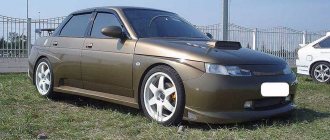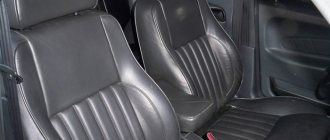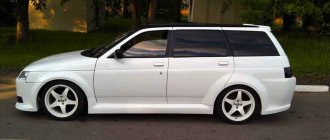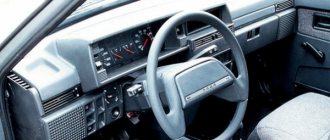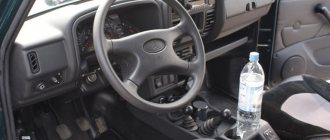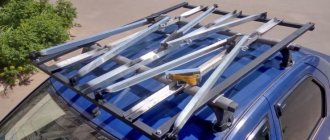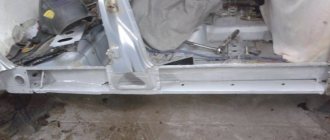Engine VAZ 1111
Oka engine 650 cc. turned out from half of the 2108 power unit. The choice of exactly half of the already developed block and the engine itself was determined by the cost of developing equipment for the manufacture of a 2-cylinder engine. A design feature of this in-line petrol twin is the overhead camshaft, which controls the operation of four valves - 2 for each cylinder.
The working process in the engine occurs in two revolutions of the crankshaft, which causes vibrations during operation of the internal combustion engine. To compensate for the imbalance, two balancing shafts are installed to dampen vibration. Engine power is 29 hp. The maximum torque is 44.1 Nm, which is achieved at 3400 rpm.
The fuel supply system is made according to the Euro-0 standard based on a carburetor. The fuel pump is mechanically driven by engine components.
The oil system is similar to the original 2108 using a gear pump. Oil is taken from the crankcase and sent through internal channels directly to the rubbing pairs of the camshaft and crankshaft.
The cylinder walls are lubricated by oil mist generated when the crankshaft rotates. The valve stems and parts of the valve timing mechanism, with the exception of the camshaft itself, are lubricated by gravity.
Replacing pads at the rear
Now let's talk about how to remove the brake drum to change the pads. The technology of work is as follows:
- We immobilize the car, jack up the rear and remove the desired wheel;
- Using a hammer and screwdriver, knock off the protective cap of the hub;
- Using pliers, remove the hub nut stopper;
- We twist the nut, remove the washer and tapered bearing installed under it;
- We carefully sell the drum.
- If it does not come off, remove the rubber plug on the drum, and install the hole that the plug closes opposite the adjusting nut of the spacer bar of the parking brake mechanism. By rotating this nut, we bring the pads together, which will allow you to remove the drum.
- To remove the pads, dismantle their clamps and tension springs;
- We install new pads in place of the worn ones and put the mechanism back together;
- We adjust the parking brake mechanism.
Identical work will have to be performed if the working cylinders are replaced. But after removing the pads, you will additionally have to unscrew the fluid supply line to the cylinder, and then unscrew the bolt securing it.
Engine VAZ 11113
The Oka 11113 (VAZ 11113) engine appeared in the process of refining the VAZ 2108 power unit and bringing its working volume to 1500 hp. Again, a half solution was used. The engine blocks of both 650 and 750 cc volumes were absolutely identical in appearance. The changes affected the piston diameter, which was increased from 76 to 81 mm. The engine block has been modified in internal design.
The partitions between the cylinders were thinned and the additional combustion chamber cooling circuit was eliminated. The power unit has become more highly loaded in the temperature department. This shortcoming in the early stages led to jamming of the pistons, the formation of scuffing on the cylinder walls and other malfunctions arising due to insufficient cooling.
Due to the modifications, the 11113 engine became more powerful and already produced 35 hp. and 52 Nm of thrust. The engine remained carburetor and complied with Euro-0 environmental requirements.
Working mechanisms
The VAZ Oka uses two types - disk (in the front) and drum (on the rear bogie).
The front mechanisms consist of non-ventilated discs fixed to the hub, calipers with a so-called floating bracket and friction pads installed in special guides mounted on the stationary part of the hub.
Related link:
Clutch OKA
The caliper is single-piston, so the working piston acts only on one pad, but due to the floating caliper, when braking, the caliper itself, with its body, also presses the second pad to the disc.
The rear mechanisms consist of:
- Brake shield;
- Drum;
- 2 pads;
- Working cylinder (two-piston);
- Parking brake mechanism;
The shield is a stationary element and a number of components are fixed to it - a cylinder, pads, and a handbrake mechanism. The brake drum is part of the wheel hub and is movable (rotating).
In general, the working mechanisms are identical in design to the VAZ-2108, but the dimensions differ - the diameter and thickness of the brake disc are smaller, and accordingly the pads and caliper are also more compact. The same applies to the rear mechanisms.
Basic faults
The main malfunctions of the first 650 cc engines and engine 11113 include increased noise and vibration. Increased noise appears when the engine warms up and is caused by the presence of balancer shafts. The noise is considered normal, although it causes concern for car owners.
Increased valve clearances can cause additional noise. Eliminated by adjustment. Vibration has a constructive reason and is caused by the operation of only 2 pistons, which have a working stroke of only 2 rotations of the CV, that is, during operation, 1 piston rotates the CV by 360 o.
Burnt out cylinder head gasket. It is caused by inaccurate manufacturing of gaskets in factories and improper tightening of the cylinder head, which allows the gasket to be incompletely compressed. During repairs, reuse of this sealing element is not allowed. Mandatory replacement is required, in this case you should pay attention to the surface of the gasket and if scuffing is detected, you should not use it.
Difficulties in starting a hot 750 cm 3 engine are due to the fuel pump diaphragm and the layout of the engine compartment. Elevated operating temperatures of the engine block lead to the formation of fuel vapors in the cavities of the pump, and the unit is not intended for pumping a gaseous medium.
If a malfunction occurs on the highway, just place a dampened rag on the pump body. This will be enough to get to the base location and replace the diaphragm.
Loss of spark. The spark generation system in the cylinders is made according to a non-contact circuit using an ignition coil. The location of the coil allows water to enter when passing through puddles. This causes failure of the voltage boosting element and results in the inability to start the engine.
Cooling system. It has the same problems as all VAZ engines. Poor quality of the pump leads to its failure, which in due course leads to overheating of the engine. The same applies to the reliability of the thermostat. If problems arise, elements need to be replaced.
Failures of electronic sensors. They are caused by poor-quality electronics by Russian manufacturers, as well as poor assembly standards of power units, which allow for incomplete fixation of sensors on the motor housing.
Repair of the OKA engine can be performed in a garage if you have experience in servicing and repairing Russian-made internal combustion engines. With the exception of specific elements, engine repairs are carried out using components used for repairing VAZ 21083 and VAZ 21093 engines.
Changing the working fluid, bleeding the brakes
According to the regulations, brake fluid requires replacement every 2 years of vehicle operation. The technology for performing this maintenance is not complicated, but it is better to do it with an assistant.
The essence of the work is as follows:
- We put the car on the inspection hole;
- Use a syringe to pump out the waste liquid from the tank;
- Fill the tank with new fluid to the level;
- On the brake mechanisms we find the bleeder fittings, clean them, and put transparent silicone tubes on them (corresponding in diameter). We lower the ends of these tubes into prepared containers. Loosen the fittings a little;
- The liquid will begin to flow by gravity through the tubes into the container. We ask an assistant to monitor the level in the tank and replenish it in a timely manner;
- We monitor the tubes, and having discovered that new fluid has flowed through them, we tighten the fittings;
- We bring the level in the tank to normal;
Related link:
Carburetor "Oka"
After replacement, the Oka brakes must be bled to remove air from the system.
Pumping on the Oka is carried out using the technology “from the near working mechanism to the far one”, taking into account the contours. That is, the front left wheel is pumped first (in the direction of travel of the car), then the rear one on the right. Bleeding the secondary circuit is also performed from the front brake mechanism.
The pumping technology is simple - we put a tube on the fitting and lower it into a container with liquid. We ask an assistant to pump the brakes (press the pedal a couple of times and then hold it down). Next, unscrew the fitting a little and wait until the liquid drains (in this case, the pedal will go to the floor all the way). We perform the procedure of pumping up the brakes and draining the fluid 2-3 times, after which we move on to the next brake mechanism. When pumping, it is also important to constantly monitor the level in the tank and replenish it in a timely manner.
Maintenance of Oka engines
The Oka engine of both the first and second generations is quite reliable. And if the factory requirements for maintenance regulations are met, it has a service life of 120,000 km.
According to the vehicle passport, both engine 11113 and engine 1111 have a maintenance program every 15,000 km. To undergo maintenance at this interval, it is recommended to use fully synthetic motor oil. When using semi-synthetics, and even more so mineral motor oils, the Oka engine requires changing the lubricant in accordance with the service life of the oil, that is, at least 10,000 km.
In this case, the oil system must be flushed and the filter element replaced. The oil volume in the Oka engine is 2.5 liters, but when replaced, 150-300 ml of lubricant remains on the engine walls, so the filling volume is controlled by the dipstick. Overfilling of oil is not allowed.
Bleeding the hydraulic brake system of VAZ "OKA" 1111 1988-2008
The hydraulic brake drive is pumped to remove air from it that entered when the hydraulic drive was filled with fluid after its replacement or after repair of hydraulic drive units associated with its depressurization.
Signs of air getting into the hydraulic drive are:
– when you press the pedal once, the pedal travel increases, its “softness”;
– with repeated pressing of the pedal - a gradual decrease in the pedal stroke with a simultaneous increase in its “hardness”.
Before bleeding the hydraulic drive, it is necessary to identify and eliminate the cause of depressurization.
If pumping a hydraulic drive is associated with the repair of any one circuit, while the serviceability of another circuit is known, then pumping only the circuit being repaired is permissible.
The steps for bleeding the hydraulic drive are exactly the same as when replacing the brake fluid (see “Replacing the brake fluid in the hydraulic drive”). The difference is that the criterion for completing the bleeding of the wheel cylinder is the cessation of air bubbles coming out of the hose, and not the appearance of fresh brake fluid.
Repairing auto parts yourself is a responsible task that should be taken as seriously as possible. Sometimes a faulty spare part takes the driver by surprise, forcing him to spend a lot of time and money searching for a good service station, but there is an alternative solution to the problem; this requires a small amount of knowledge and a set of tools.
When repairing the hydraulic bleed of the brake system of a VAZ "OKA" 1111 1988-2008, you need to be extremely careful and not neglect the little things. To get acquainted with the issue, car enthusiasts often use various Internet portals dedicated to auto parts. Some of them use narrowly focused forums. But, as a rule, only generalized information is provided there, which is known initially. Where can you find a reliable source that offers really useful things? Our portal is open for this 24 hours a day. Online mode allows us to help clients at any time convenient for them. Moreover, a mobile version has been developed that is available to everyone.
A detailed description of such a unit as bleeding the hydraulic brake system of the VAZ "OKA" 1111 1988-2008 has a good structure with thematic headings. In addition, there is always the opportunity to familiarize yourself with the intricacies of installation. There are often situations when a driver is confident in his abilities, but when he gets down to work, questions begin to arise. Thanks to our portal, such moments can be easily avoided. The site is a database that is updated regularly. By using it as a support during repair work, the car enthusiast receives a serious advantage. Each of the articles has reliable support, tested in practice.
In addition to the repair manual, the owner of a personal car will be able to prevent a lot of breakdowns that occur due to the human factor, thanks to the information located on the site. Users are presented with a lot of useful recommendations for proper operation, which will help significantly extend the life of the unit and avoid many negative consequences.
Online support is an excellent and most convenient way to obtain the necessary information. Another significant plus is that articles are written for people. We understand that the reader will do everything with his own hands, and we try to make it as convenient and efficient as possible. Use the resource at any time of the day and find the answer to any question you may have regarding cars.
Source of the article: https://automend.ru/vaz-oka/139.html
Tuning and modification of Oka engines
Tuning the Oka engine does not make practical sense under normal operating conditions. Increasing power and torque when flashing ECM units can give an increase of up to 10% horsepower, which is about 30 hp. will not be particularly practical.
As a garage modification, Oka engine tuning is performed by installing an injector from a VAZ 21083i, but the cost of modification can be comparable to installing a Chinese liter TJ376QE FAW engine (Daihatsu), which was mounted on a Serpukhov-made SeAZ Oka 11116-02 car in 2007-08.
Brake upgrades
One of the main disadvantages of the Oka brake mechanisms is that they are not unified with the parts of other VAZ models. That is, if components related to the drive can be found in almost any auto store, then you will have to look for parts for the operating mechanisms.
Related link:
How to remove the engine from Oka
A way out of the situation may be to modify the mechanisms for installing parts from other cars. For example, the rear brake cylinder from the VAZ 2101-2107 fits on the Oka, but after a slight modification of the shield.
Some car owners completely modernize factory working mechanisms, essentially replacing the “original” components with mechanisms from the VAZ-2108 or other models.
Due to the simplicity of the design, the Oka brake system is quite easy to alter and modify.
Other small-scale Oka power units
Only VAZ 1111 and VAZ 11113 engines were serially installed on the car. It was with these power units that the car was supplied to retail chains.
As options to save production and meet environmental requirements, both SeAZ and KAMAZ tried to use power units from other manufacturers. This was due to the fact that AvtoVAZ refused to continue producing minicars and actually stopped supplying power units to complete the car.
So in 2004, a trial series of cars with a Korean Hyundai Atos engine was produced. 15 cars were produced for trial testing, but the program did not go into series.
Also this year, small-scale tests were carried out at SeAZ of cars with engines from the Melitopol plant MeMZ 245. The car was called OKA-Astro and was subsequently produced in small series at the Kamov automobile assembly plant. Another version of the Ukrainian power unit was MeMZ 247.1. This engine, which complied with Euro-2 requirements, was not supplied for mass production, although such equipment is rarely found on the secondary market.
In 2007-2008, a Chinese three-cylinder injection engine was installed at the Serpukhov plant, which developed 53 hp.
The sports version of the Oka uses the engine from Priora.
The Oka-based tracked all-terrain vehicle uses a VAZ 2131 engine.
As an option for garage tuning, there are several examples of cars using three-cylinder Volkswagen diesel engines.
When installing shafts and heads there was always a feeling - they are capable of more, something is missing. Yes, there are results, and they have been achieved - engine 11113 produced 39-40 horses. For some it was enough, for others it was not. When I switched from the RS58 shaft to the RS628 , the highs improved, but overall it seemed to me that the shaft was defective or something. In particular, the torque at medium speeds has deteriorated, a noticeable pickup has appeared after 4500 rpm, and there is a torque hump at the bottom. But something was wrong, and the RS584 shaft sometimes gave more power in measurements than my motor. I was already starting to think that the shaft was bad, or I was doing something wrong.
I didn’t think about modifying the carb - the combination of jets was selected, the engine seems to be running... They stopped reports from losers who sawed carbs, then they were removed because of their unsatisfactory performance. From their reports it followed that they did not see any results, and what could they see without having any diagnostic instruments on hand except their ass accelerometer? And so, recently something happened - we need to make a carb. The trial carb was disassembled and lay on the table for 2-3 months, having already stopped emitting any odors out of despair. But, having assembled a cylinder head with M11 shaft for Nikolai, I made a 21x27 . A head with a sports shaft and carb was installed and showed excellent results, but I will write about them later. I came home inspired - and the next day I made two 21x28 .
But first, a few words about the car. OKA, engine 11113, modified cylinder head and RS628 shaft. In January, the Motor Tester showed 39 hp. , which upset me somewhat at first - in comparison with the serial graph, a clear “provision” was visible in the average speed. It was inconvenient while driving - the maximum speed and acceleration time were lost. The results were as follows - 39 hp. at 5500 rpm , torque 5.5 kg at 2800 rpm , at 6000 rpm an increase of 1.1 kg and 9 hp. On the graph below the blue line is cr. torque of a serial internal combustion engine, red - power of a serial internal combustion engine, dotted line - respectively torque and power of my engine (click on the screenshots to enlarge):
In the spring of 2008, after a run of about 50 tkm after boring, I replaced the pistons and rings (without boring), I installed SM , which increased the engine efficiency by reducing friction in the “cylinder-ms ring” pair. Removing the VSKh again inspired me - the engine produced 43 hp. , noticeably raising the torque line after 5000 rpm . However, up to 5000 rpm everything remained unchanged. The measurement result is 43 hp. power at 5700 rpm , torque 5.5 kg at 5400 rpm (the second, top, “hump” became higher than the first). The increase at 6000 rpm was already 1.7 kg and 14.5 hp. Let's look at the graph (dotted line - VSKH before and after replacing the pistons):
And so, I installed a bored-out carburetor. It was a shock in every sense. After test rides, my hands were shaking. The carburetor required a different combination of jets, which is quite understandable - the diffusers increased, the flow rate decreased. The engine shook - the Motor Tester produced 46 hp. at 6000 rpm , the torque is already 6 kg at 5300 rpm , the increase at 6000 rpm was 2.2 kg (.) and 18.5 hp. (. ) . Need I mention that the production engine at 6000 rpm produces a measly 3.3 kg of torque and 28 horses! And here at 6000 rpm – 5.5 kilograms and 46 horses! But the main thing is to look at the graph. It all rose up, the gap between the humps leveled out and almost became level, forming a long shelf of torque - from the bottom to the top! The blue and red lines are the torque and power of the serial 11113 internal combustion engine, the purple lines are the torque and power after replacing the pistons and rings, the red dotted lines are after installing and tuning the 21x28 carburetor.
And once again let's look at the final graph 46 horsepower engine. Pay attention to the scale at the top of the screen, showing the amount of power and torque at certain speeds - it’s easy to see that the motor shows a flat torque level within 5-6 kg of torque in almost the entire range. From the bottom to the top. Look at 7000 rpm - there are 4.1 kilograms of torque and 41 hp. !!
Content
Today, compact cars are quite popular. They are ideal for urban environments, as they are compact and economical. The class under consideration includes the VAZ 1111, which is also called “Oka”. The car began production in 1987, production was closed in 2008. The model is a prominent representative of the budget class, which determines the accessibility of the car. The fact that its production was established more than ten years ago is determined by outdated technical equipment. That is why many people decided to do the tuning of the VAZ 1111 with their own hands.
What can the Oka be converted into?
The car in question can be upgraded in a variety of ways. The most common modernization methods are:
- Creation of an SUV. Even though the car has a low ground clearance, it can be converted into an SUV.
- Roadster. This name refers to a two-seater car with increased comfort.
- Cabriolet. If desired, you can use Oka to create convertibles: two doors, quite a spacious interior for two seats. However, it is worth remembering that there will be no room for a roof.
- Rally car.
The easiest way is to make an SUV, since it is enough to change the suspension and some body elements, and install large-diameter wheels. But other modernizations, for example the creation of a convertible, require serious interventions.
Types of tuning
Remaking the Oka car can be done in different ways:
- Version for rally racing.
- SUV.
- Retro versions. Concepts from the 60s and 70s of the 20th century, characterized by angular body lines and bright colors.
- Roadster.
- Cabriolet.
Converting the Oka for off-road use is the simplest and most common tuning variation. To highlight and enhance the off-road characteristics that the VAZ-1111 already has, it is enough to lift the suspension, install tires with a powerful tread and large rims. The listed changes are considered the first stage in the process of creating the Oka all-terrain vehicle.
The design of the front optics and radiator grille allows you to stylize the VAZ-1111 as a Grand Cherokee SUV. To do this, install wheels of larger diameter, tires with tractor tread, a special body kit and change the configuration of the hood. This modification of the Oka allows you to turn the car into a miniature clone of the popular SUV.
The simplicity of the design and primitive appearance of the VAZ-1111 simplify tuning, making it more accessible and simple and allowing for various experiments.
Engine tuning to increase power
When considering how to improve this car, you should pay attention to the installed engine. It has a relatively low power rating and low reliability.
There are two methods for improving the motor:
1. Installing a new one, for example, taken from a Rover Mini. This power unit has a volume of 1.3 liters, as well as higher reliability. This modernization method is considered preferable, as it can significantly improve the performance of the car. However, the method has one significant drawback - the high cost of implementation.
2. The second option involves improving the standard design. This method is cheaper and easier to implement, and allows you to achieve a high power level. Engine tuning begins with changing the carburetor: increasing the diameter of the throttle valve allows for the supply of a large amount of air, as well as increasing the service life of the structure. A new camshaft can be installed, which will also increase the number of revolutions. Replacing standard valves increases engine power and changes the combustion chamber. Modernization of intake and exhaust manifolds, installation of a new air filter - all these changes also increase engine power.
In general, we can say that there are quite a few methods for modernizing a motor. The engine that comes from the factory does not have high driving performance.
Drive unit
Comprises:
- Pedals;
- Vacuum booster (VUT);
- Brake master cylinder (MBC);
- Brake force regulator;
- Highways and pipelines;
Many drive components are “borrowed” from other VAZ vehicles. Thus, the GTZ used on the Oka was also installed on the VAZ-2121 Niva; the amplifier was taken from the classic VAZ 2101-2107 family.
Pedal, amplifier
Using the pedal, the driver applies the brakes as needed to slow down or stop. It fits into the pedal unit installed in the cabin and is located in the middle.
The pedal is connected to the VUT rod. The amplifier itself is of a classic design and consists of a housing with a spring-loaded membrane installed inside, which divides the housing into two chambers. This unit operates due to pressure difference. The vacuum in one of the chambers is created by the power unit, for which the housing is connected to the intake manifold through a tube.
The operation of the amplifier is quite simple - when the brake pedal is released, the pressure in the chambers of the unit is the same. When braking, the driver, pressing the pedal, moves the rod, moving it opens a special valve that connects one of the chambers to the atmosphere. At the same time, since a vacuum is maintained in the second chamber, atmospheric pressure puts pressure on the membrane, causing it to bend. When deflected, it pushes the rod connecting the amplifier to the GTZ, thereby creating additional force to operate the drive. The amplifier functions only when the power unit is running.
Master cylinder
GTZ is the main drive unit. Its task is to create fluid pressure, which activates the working mechanisms. This cylinder is a two-piston cylinder with a sequential arrangement of pistons. Each of the pistons is responsible for supplying working fluid to two brake mechanisms, thereby providing a dual-circuit braking circuit.
When braking, the rod coming from the amplifier pushes the first piston. By shifting, it pushes the liquid into the line, and at the same time pushes the second piston, which ensures the creation of liquid pressure in the second circuit. The pistons are returned to their original position by springs.
Thanks to the sequential arrangement of the GTZ pistons, the operation of the unit is maintained in the event of depressurization of one of the circuits.
The fluid is supplied to the drive from a special tank, the connection between which is made by rubber hoses. A float-type sensor is installed in the reservoir lid, connected to a brake fluid level indicator lamp installed on the front panel.
Among the design features of the GTZ installed on Oka, one can highlight the presence of only three outputs for connecting highways.
The first working chamber of the GTZ has two outlets and from it the liquid is supplied to the right front and rear left wheels. In this case, the line leading to the rear wheel leads to the mechanism not directly, but through the regulator.
The second GTZ chamber has only one outlet, and it leads to a tee, which divides the fluid flow into two channels leading to the front left and rear right (through the regulator) wheels.
The circuit diagram on the Oka is diagonal, that is, one circuit connects one front and one rear brake mechanisms diagonally (the front left and rear right wheels are the 1st circuit, the other two are the 2nd circuit). Thanks to this scheme, the car retains the ability to brake in case of depressurization of any circuit.
Regulator, lines
The brake force regulator is designed to reduce fluid pressure on the rear operating mechanisms when braking, which prevents their premature blocking, thereby preventing the car from skidding during heavy braking. This unit only works with rear brakes.
The amplifier, turbocharger, reservoir and regulator are installed in the engine compartment near the shield that separates the engine from the passenger compartment, on the right side (if you stand in front of the car).
The lines along which fluid moves to the mechanisms are composite. All drive elements are connected to each other by copper pipelines, which also go to the working mechanisms. But rubber brake pipes are used to connect the mechanisms to the drive, so the operation of the suspension does not affect the functioning of the brakes.
Common methods of body tuning
The exterior design of the car in question does not look modern and is very simple. That is why many are considering the possibility of upgrading the body. Just a few years ago, body tuning involved creating a body kit yourself - painstaking work that required certain skills and technical equipment. However, today you can carry out tuning by purchasing a special kit. This tuning method can be characterized as follows:
- All elements are easy to use and do not require major modifications. When creating the kits in question, they are ideally adjusted for installation on a car.
- The entire body kit is made in the same style, which allows you to complete the style of the car.
- Installation work does not take much time. The fact that there is no need to change the design determines a significant acceleration of work. It is represented only by dismantling old elements and installing new ones. You need to be prepared for the fact that some fasteners will be covered with corrosion and dismantling will be difficult, and after removing the body kit, body defects will be discovered that require restoration.
- The cost of the sets sold is relatively low. Of course, homemade options will be much cheaper, but only if they are done on the first try.
In this way, you can significantly modify the car in question. However, this method only changes the Oka in appearance; significant modernization requires more serious intervention.
Replacing pads at the front
The next brake maintenance operation that will have to be performed periodically is replacing consumables, in particular brake pads.
Since a small car uses two types of working mechanisms, you should know how to correctly change the brake pads on an Oka.
On the front wheels this operation is performed as follows:
- We immobilize the car;
- We jack up the wheel on which the pads are being changed;
- Remove the wheel;
- We remove the brake hose from the bracket on the shock absorber strut;
- We bend the antennae of the locking rings, which prevent unauthorized unwinding of the caliper mounting bolts;
- Unscrew the caliper fasteners;
- We remove the caliper and hang it on the stand using a wire (so that the rubber hose is not stretched);
- We remove the worn pads;
- Before installing new pads, we “recess” the piston in the working cylinder so that the caliper can “sit” on the new pads;
- Putting the unit back together.
Similarly, you will have to disassemble the mechanism if you need to replace the Oka brake disc. That is, to remove it, you must first dismantle the caliper, and then:
- Unscrew the fastening of the pad guide and remove it;
- Unscrew the bolt securing the disc to the hub;
- We remove the disk together with the spacer ring (if necessary, they can be knocked down using a hammer and a wooden adapter);
Related link:
How to start a VAZ engine in winter
Then all that remains is to put everything back together by installing a new disk.
Interior modification - how to do tuning?
When considering the most popular tuning methods, do not forget about the possibility of changing the interior. Let's highlight the following most popular tuning methods:
- Interior insulation. In order to feel comfortable while driving in noisy cities, you should take care of proper insulation.
- Installing more comfortable seats. The seats installed in the car at the factory, to put it mildly, do not provide adequate comfort.
- Modernization of control units and instrument panel. An example is the work of changing the instrument panel in order to increase the readability of information.
- Improving the quality of finishing. You can also install panels from high-quality materials.
Important! You can finish the interior at the lowest cost due to the fact that there are quite a large number of ready-made kits on sale.
Remodeling Oka's salon according to Feng Shui
The first impression of the interior may seem sparse and insufficient for such a powerful car. Tuning the Oka's interior includes interior firmware, modern upholstery with high-quality material, installation of electric glass lifts and high-quality vibration and noise insulation. Head units, midbass, amplifiers and subwoofer are being updated.
The dashboard is also equipped with sound insulation, and electric lifts can move the windows at the touch of a button. The pedals have aluminum pads, which are often found in sports cars. A loud rectangular muffler will highlight the spirit of sport.
The car has a low degree of passive safety, so this feature needs to be urgently corrected. For the safety of passengers and the driver, install a safety panel and additional airbags. Plus, you can install disc brakes and a dynamic stabilization system.
Sometimes, as an Oka tuning, car enthusiasts purchase starting chargers. Such devices are necessary on the road when the battery runs out randomly. Additionally, you can decorate your car with interesting multi-color airbrushing and vinyl decoration.
Here, give free rein to a professional artist, and he will create a “car” that will surprise and stun everyone on the road. The most popular paintings on the body are in the fantasy style, dark castles, uncharted planets, stars, or the sky.
Providing car tuning services
You can modernize the Oka yourself or entrust this work to professionals. When considering the services provided by professionals, we note the following points:
- Such companies appeared relatively recently and provide professional services for car modernization.
- The cost of services is quite high, but this is how they can change a car almost beyond recognition.
As a rule, the services of such companies are used by those who have enough money to replenish their garage with a tuning car. This is due to the fact that even with proper and high-quality tuning, many of the Oka’s shortcomings will remain.
Experts' comments
Yuri. In order to carry out tuning of expensive cars, you must have the necessary skills. To obtain them, I decided to use Oka as a training ground. This is due to the fact that the design of this model is simple, and the compact car itself has a relatively low cost. It is possible to modernize almost all components; the only question is how much time and money can be spent on this.
Michael. I got the Oka for practically nothing. There is another car in the garage, but I still decided to leave it, since I still won’t be able to get a lot of money by selling it. In order for it to be able to be used somehow, it was modified for an SUV. Now there is something to drive in the forest and on the field.
Victor. Considering the VAZ 2121 and its modernization, I note that the car has a simple design. The installed motor requires significant changes, like other power units.
see also
Which brake fluid is better
Replacing brake fluid
How much brake fluid do you need to change?
Master brake cylinder repair kit
Brake fluid DOT 4
Knowing how to bleed brakes will be useful to any driver, since the procedure is not very complicated, and it must be performed after many manipulations related to the brake system. So why waste extra money once again by sending your car for service when you can pump the brakes alone?
By following the instructions and avoiding the mistakes described below, it is quite possible to remove the air from the brakes yourself, with or without ABS. Bleeding brakes with ABS is by no means more difficult, but still it is a separate topic worthy of its own article.
It is only worth noting that if there is an anti-lock braking system with ESP and SBC modules, then the path lies with a service that has the necessary equipment.

